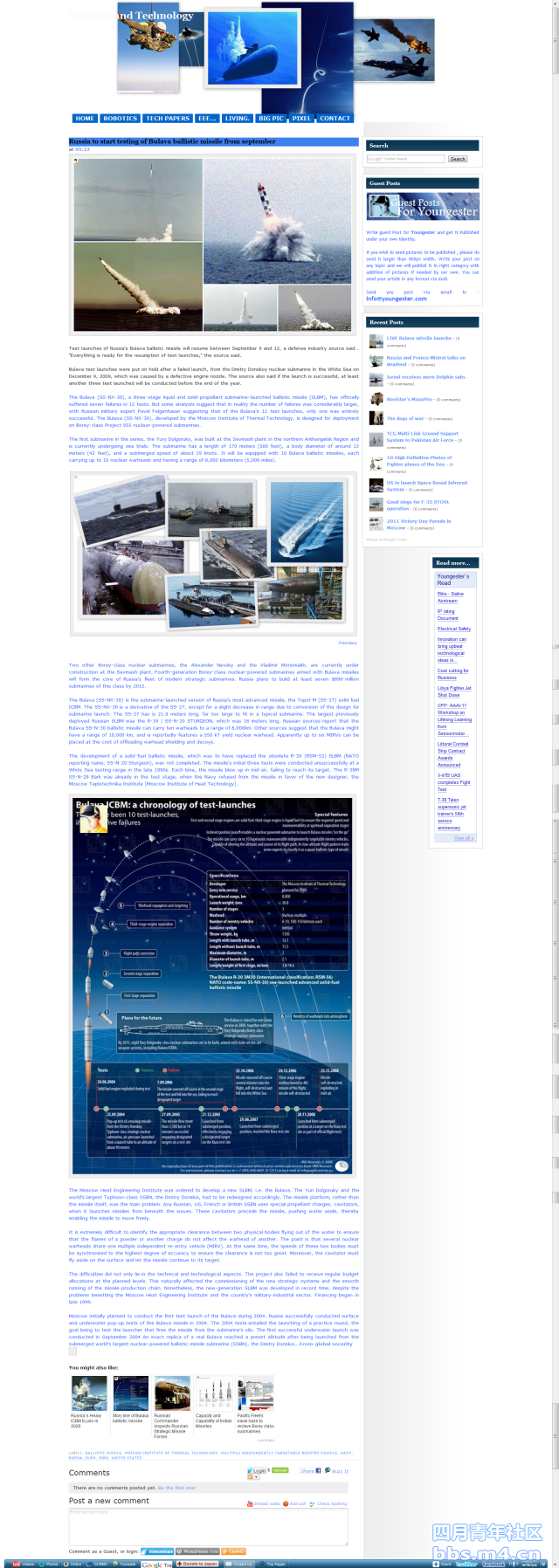|
|
Test launches of Russia's Bulava ballistic missile will resume between September 9 and 12, a defense industry source said . "Everything is ready for the resumption of test launches," the source said.
Bulava test launches were put on hold after a failed launch, from the Dmitry Donskoy nuclear submarine in the White Sea on December 9, 2009, which was caused by a defective engine nozzle. The source also said if the launch is successful, at least another three test launched will be conducted before the end of the year.
The Bulava (SS-NX-30), a three-stage liquid and solid-propellant submarine-launched ballistic missile (SLBM), has officially suffered seven failures in 12 tests. But some analysts suggest that in reality the number of failures was considerably larger, with Russian military expert Pavel Felgenhauer suggesting that of the Bulava's 12 test launches, only one was entirely successful. The Bulava (SS-NX-30), developed by the Moscow Institute of Thermal Technology, is designed for deployment on Borey-class Project 955 nuclear-powered submarines.
The first submarine in the series, the Yury Dolgoruky, was built at the Sevmash plant in the northern Arkhangelsk Region and is currently undergoing sea trials. The submarine has a length of 170 meters (580 feet), a body diameter of around 13 meters (42 feet), and a submerged speed of about 29 knots. It will be equipped with 16 Bulava ballistic missiles, each carrying up to 10 nuclear warheads and having a range of 8,000 kilometers (5,000 miles).
Two other Borey-class nuclear submarines, the Alexander Nevsky and the Vladimir Monomakh, are currently under construction at the Sevmash plant. Fourth-generation Borey-class nuclear-powered submarines armed with Bulava missiles will form the core of Russia's fleet of modern strategic submarines. Russia plans to build at least seven $890-million submarines of this class by 2015.
The Bulava (SS-NX-30) is the submarine-launched version of Russia’s most advanced missile, the Topol-M (SS-27) solid fuel ICBM. The SS-NX-30 is a derivative of the SS-27, except for a slight decrease in range due to conversion of the design for submarine launch. The SS-27 has is 21.9 meters long, far too large to fit in a typical submarine. The largest previously deployed Russian SLBM was the R-39 / SS-N-20 STURGEON, which was 16 meters long. Russian sources report that the Bulava SS-N-30 ballistic missile can carry ten warheads to a range of 8,000km. Other sources suggest that the Bulava might have a range of 10,000 km, and is reportedly features a 550 kT yield nuclear warhead. Apparently up to six MIRVs can be placed at the cost of offloading warhead shielding and decoys.
The development of a solid-fuel ballistic missile, which was to have replaced the obsolete R-39 (RSM-52) SLBM (NATO reporting name, SS-N-20 Sturgeon), was not completed. The missile's initial three tests were conducted unsuccessfully at a White Sea testing range in the late 1990s. Each time, the missile blew up in mid-air, failing to reach its target. The R-39M SS-N-28 Bark was already in the test stage, when the Navy refused from the missile in favor of the new designer, the Moscow Teplotechnika Institute [Moscow Institute of Heat Technology].
The Moscow Heat Engineering Institute was ordered to develop a new SLBM, i.e. the Bulava. The Yuri Dolgoruky and the world's largest Typhoon-class SSBN, the Dmitry Donskoi, had to be redesigned accordingly. The missile platform, rather than the missile itself, was the main problem. Any Russian, US, French or British SSBN uses special propellant charges, cavitators, when it launches missiles from beneath the waves. These cavitators precede the missile, pushing water aside, thereby enabling the missile to move freely.
It is extremely difficult to identify the appropriate clearance between two physical bodies flying out of the water to ensure that the flames of a powder or another charge do not affect the warhead of another. The point is that several nuclear warheads share one multiple independent re-entry vehicle (MIRV). At the same time, the speeds of these two bodies must be synchronised to the highest degree of accuracy to ensure the clearance is not too great. Moreover, the cavitator must fly aside on the surface and let the missile continue to its target.
The difficulties did not only lie in the technical and technological aspects. The project also failed to receive regular budget allocations at the planned levels. This naturally affected the commissioning of the new strategic systems and the smooth running of the missile-production chain. Nonetheless, the new-generation SLBM was developed in record time, despite the problems besetting the Moscow Heat Engineering Institute and the country's military-industrial sector. Financing began in late 1999.
Moscow initially planned to conduct the first test launch of the Bulava during 2004. Russia successfully conducted surface and underwater pop-up tests of the Bulava missile in 2004. The 2004 tests entailed the launching of a practice round, the goal being to test the launcher that fires the missile from the submarine's silo. The first successful underwater launch was conducted in September 2004 An exact replica of a real Bulava reached a preset altitude after being launched from the submerged world's largest nuclear-powered ballistic missile submarine (SSBN), the Dmitry Donskoi..



http://weapons.technology.younge ... ting-of-bulava.html |
评分
-
1
查看全部评分
-
|